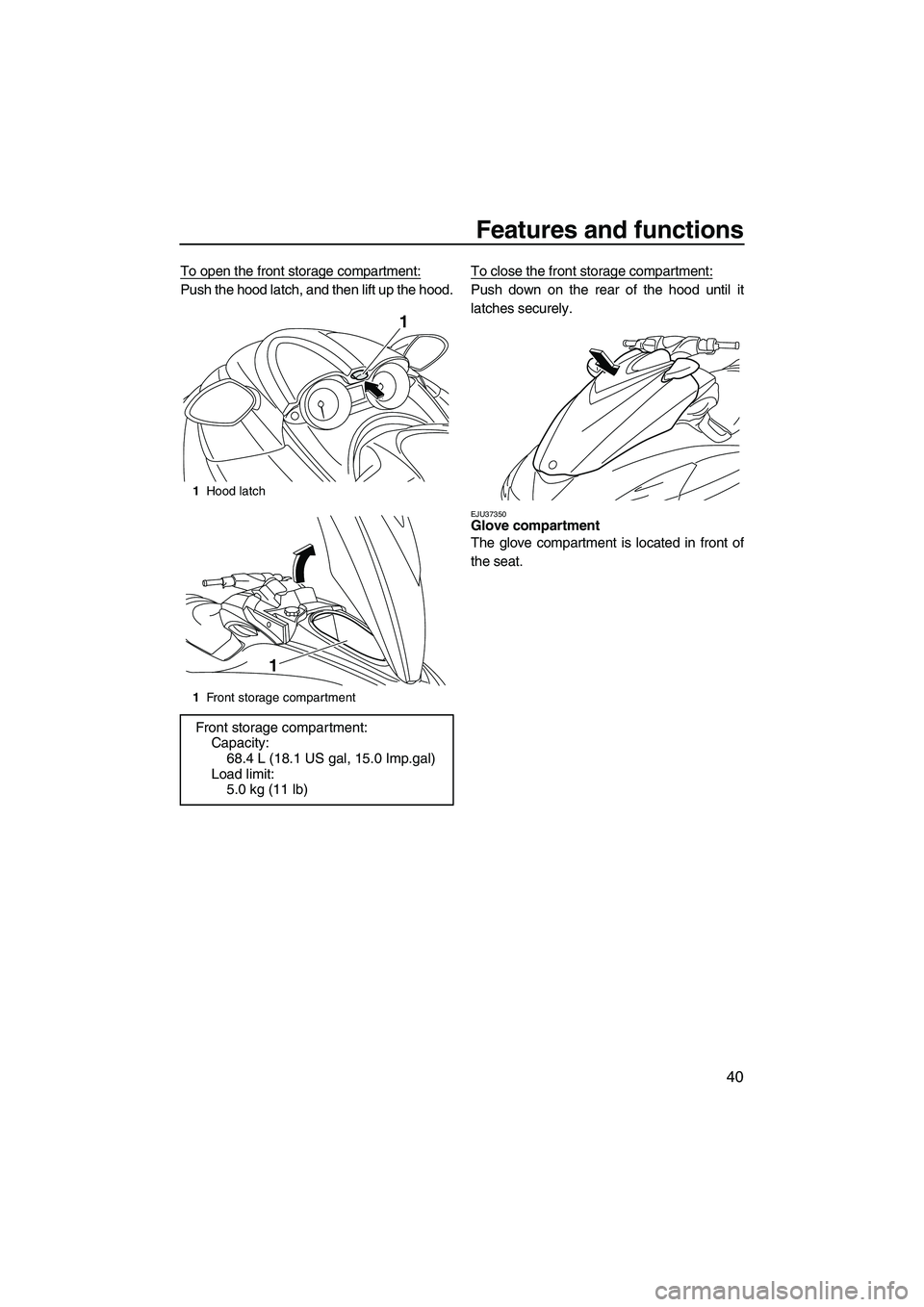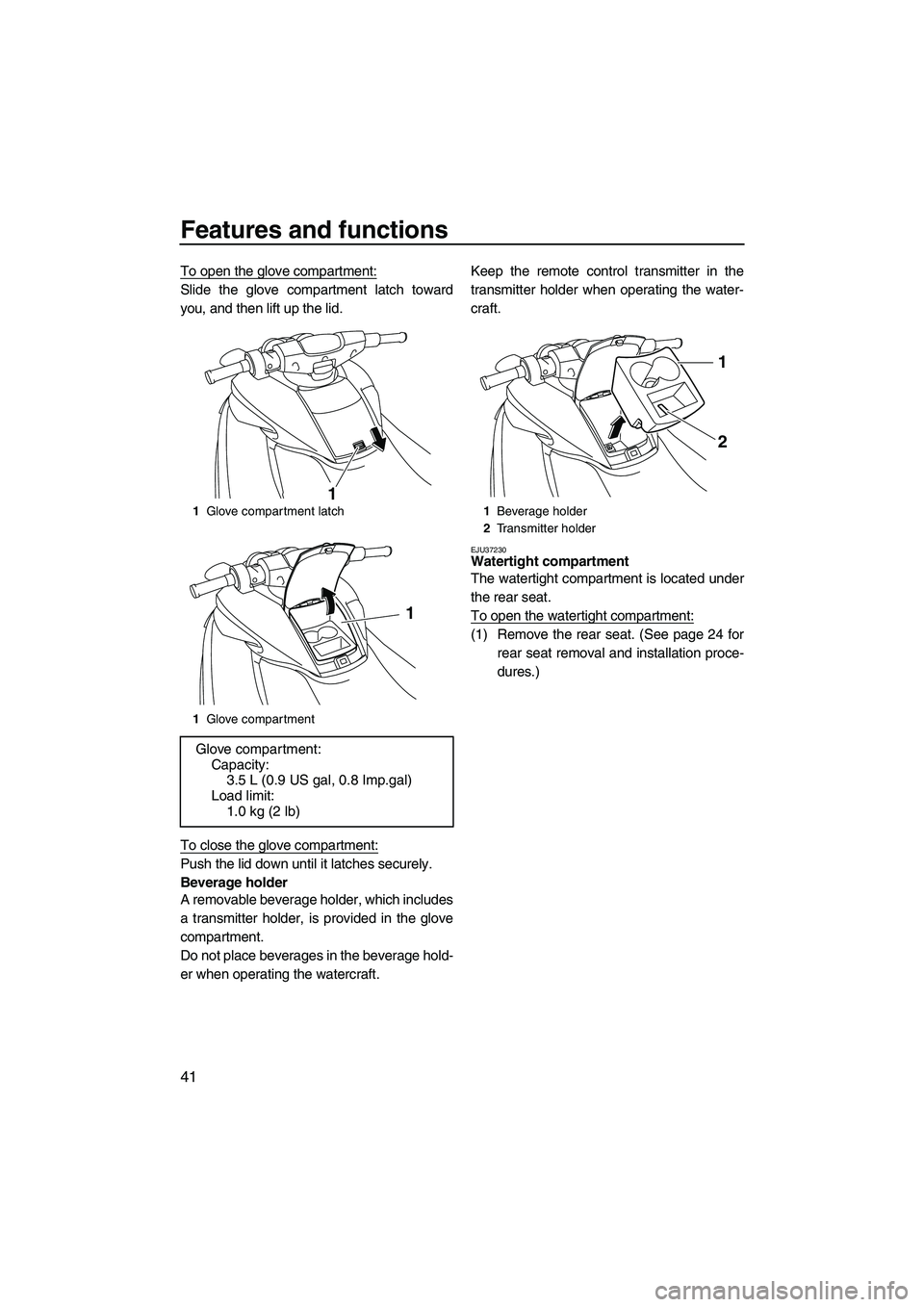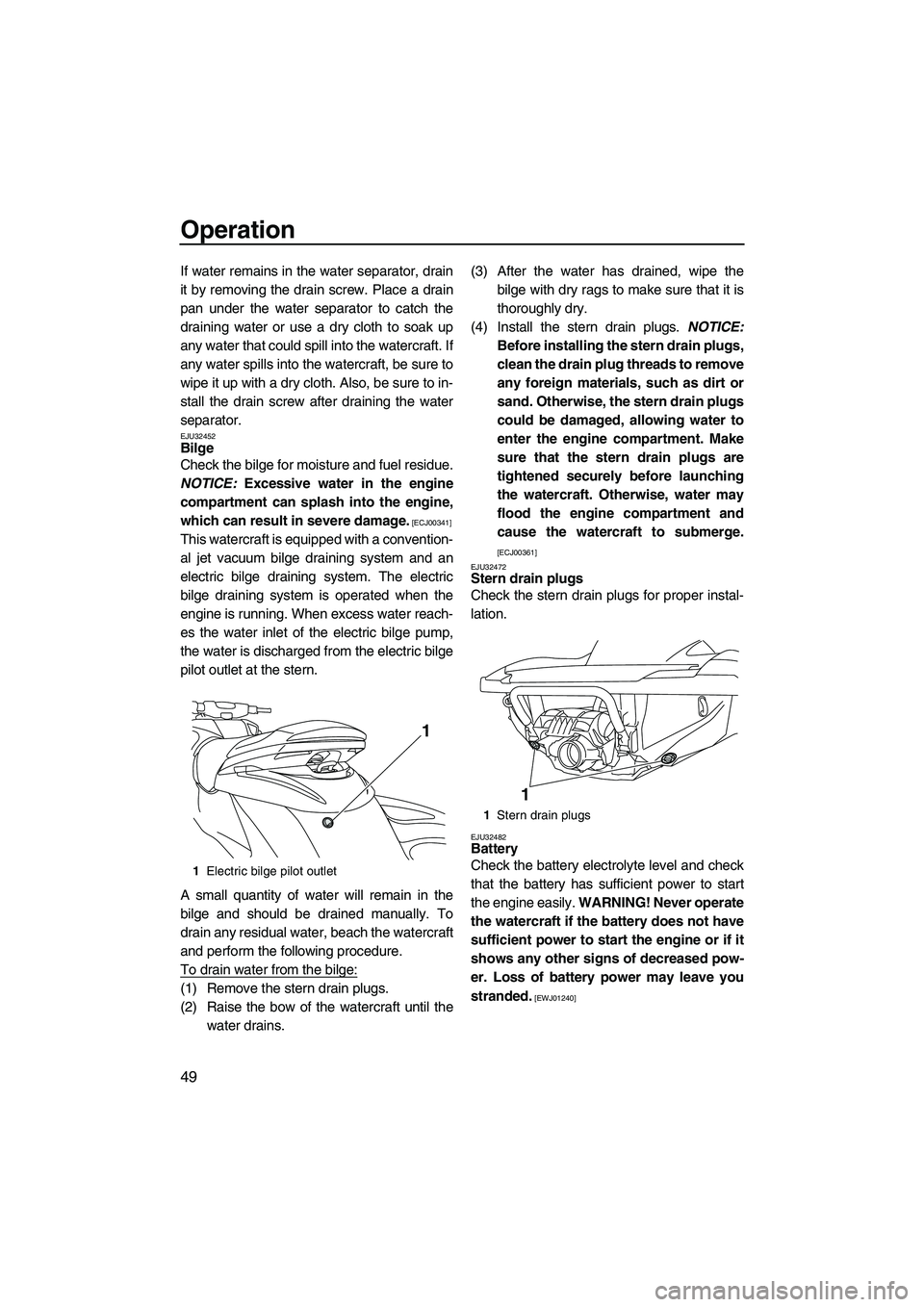2009 YAMAHA FZS ECU
[x] Cancel search: ECUPage 46 of 98

Features and functions
39
TIP:
Push the “Hour Volt” button to stop the buzz-
er.
EJU37310Check engine warning
If a sensor malfunction or a short circuit is de-
tected, the “WARNING” indicator light and the
check engine warning indicator blink, and the
buzzer sounds intermittently.
If this occurs, immediately reduce the engine
speed, return to shore, and have a Yamaha
dealer check the engine.
TIP:
Push the “Hour Volt” button to stop the buzz-
er.
EJU37320Storage compartments
A front storage compartment, glove compart-
ment, and watertight compartment are provid-
ed.
Only the securely closed watertight compart-
ment is waterproof. If you carry objects that
must be kept dry, such as the manuals, put
them in a waterproof bag.
Make sure that the storage compartments are
closed securely before operating the water-
craft.
EJU37330Front storage compartment
The front storage compartment is located at
the bow.
1“Hour Volt” button
1
1“Hour Volt” button
1
UF2C70E0.book Page 39 Monday, November 3, 2008 10:16 AM
Page 47 of 98

Features and functions
40
To open the front storage compartment:
Push the hood latch, and then lift up the hood.To close the front storage compartment:Push down on the rear of the hood until it
latches securely.
EJU37350Glove compartment
The glove compartment is located in front of
the seat.
1Hood latch
1Front storage compartment
Front storage compartment:
Capacity:
68.4 L (18.1 US gal, 15.0 Imp.gal)
Load limit:
5.0 kg (11 lb)
1
1
UF2C70E0.book Page 40 Monday, November 3, 2008 10:16 AM
Page 48 of 98

Features and functions
41
To open the glove compartment:
Slide the glove compartment latch toward
you, and then lift up the lid.
To close the glove compartment:
Push the lid down until it latches securely.
Beverage holder
A removable beverage holder, which includes
a transmitter holder, is provided in the glove
compartment.
Do not place beverages in the beverage hold-
er when operating the watercraft.Keep the remote control transmitter in the
transmitter holder when operating the water-
craft.
EJU37230Watertight compartment
The watertight compartment is located under
the rear seat.
To open the watertight compartment:
(1) Remove the rear seat. (See page 24 for
rear seat removal and installation proce-
dures.)
1Glove compartment latch
1Glove compartment
Glove compartment:
Capacity:
3.5 L (0.9 US gal, 0.8 Imp.gal)
Load limit:
1.0 kg (2 lb)
1
1
1Beverage holder
2Transmitter holder
1
2
UF2C70E0.book Page 41 Monday, November 3, 2008 10:16 AM
Page 51 of 98

Operation
44
(6) Wipe up any spilled fuel immediately.
(7) Install the fuel tank filler cap, and then
close the hood. Make sure that the fuel
tank filler cap and the hood are securely
closed before operating the watercraft.
(8) Install the seats. Make sure that the seats
are securely installed before operating
the watercraft.
EJU31891Engine oil
NOTICE
ECJ00281
Use only 4-stroke engine oil. Usage of 2-
stroke engine oil could result in severe en-
gine damage.
Make sure that the engine oil is at the speci-
fied level. Add oil as necessary. (See page 47
for engine oil level checking procedures.) Use
a combination of the recommended SAE and
API engine oil classifications shown in the
chart below. Fuel tank capacity:
70 L (18.5 US gal, 15.4 Imp.gal)
1Approximately 50 mm (2 in) from top of the
fuel tank
1
UF2C70E0.book Page 44 Monday, November 3, 2008 10:16 AM
Page 52 of 98

Operation
45
EJU31980
Pre-operation checks EJU31991Pre-operation check list
Before operating this watercraft, perform the checks in the following check list.
WARNING
EWJ00411
Failure to inspect or maintain the watercraft properly increases the possibility of an ac-
cident or damage to the watercraft. Do not operate the watercraft if you find any prob-
lem. If a problem cannot be corrected by the procedures provided in this manual, have
the watercraft inspected by a Yamaha dealer.
ITEM ROUTINE PAGE
BEFORE LAUNCH OR OPERATION
Engine compartmentRemove the seats to ventilate the engine compart-
ment. Check for fuel vapors and loose electrical con-
nections.47
BilgeCheck for water and fuel and drain if necessary. 49
Stern drain plugsCheck for proper installation. 49
Throttle leverCheck that the throttle lever springs back smoothly. 50
Steering systemCheck for proper operation.
Check that the handlebars are locked in place.51
Shift lever and reverse gateCheck for proper operation. 51
QSTSCheck for proper operation. 52
Fuel and oilCheck the fuel and oil levels and replenish if neces-
sary.
Check the hoses and tanks for leakage.47, 47
Water separatorCheck for water and drain if necessary. 48
BatteryCheck the electrolyte level and battery condition. 49
HoodCheck that the hood is securely closed. 25
Front and rear seatsCheck that the seats are securely installed. 24
Hull and deckCheck the hull and deck for cracks and other dam-
age.47
Jet intakeCheck for debris and remove if necessary. 53
Fire extinguisherCheck the condition and replace if necessary. 50
Engine shut-off cord (lan-
yard)Check the condition and replace if frayed or broken. 53
SwitchesCheck the start switch, engine stop switch, and en-
gine shut-off switch for proper operation.53
AFTER LAUNCH
Cooling water pilot outletCheck that water is discharged while the engine is
running and the watercraft is in the water.54
Dual analog meter unitCheck for warning indications and proper operation. 54
UF2C70E0.book Page 45 Monday, November 3, 2008 10:16 AM
Page 56 of 98

Operation
49
If water remains in the water separator, drain
it by removing the drain screw. Place a drain
pan under the water separator to catch the
draining water or use a dry cloth to soak up
any water that could spill into the watercraft. If
any water spills into the watercraft, be sure to
wipe it up with a dry cloth. Also, be sure to in-
stall the drain screw after draining the water
separator.
EJU32452Bilge
Check the bilge for moisture and fuel residue.
NOTICE: Excessive water in the engine
compartment can splash into the engine,
which can result in severe damage.
[ECJ00341]
This watercraft is equipped with a convention-
al jet vacuum bilge draining system and an
electric bilge draining system. The electric
bilge draining system is operated when the
engine is running. When excess water reach-
es the water inlet of the electric bilge pump,
the water is discharged from the electric bilge
pilot outlet at the stern.
A small quantity of water will remain in the
bilge and should be drained manually. To
drain any residual water, beach the watercraft
and perform the following procedure.
To drain water from the bilge:
(1) Remove the stern drain plugs.
(2) Raise the bow of the watercraft until the
water drains.(3) After the water has drained, wipe the
bilge with dry rags to make sure that it is
thoroughly dry.
(4) Install the stern drain plugs. NOTICE:
Before installing the stern drain plugs,
clean the drain plug threads to remove
any foreign materials, such as dirt or
sand. Otherwise, the stern drain plugs
could be damaged, allowing water to
enter the engine compartment. Make
sure that the stern drain plugs are
tightened securely before launching
the watercraft. Otherwise, water may
flood the engine compartment and
cause the watercraft to submerge.
[ECJ00361]
EJU32472
Stern drain plugs
Check the stern drain plugs for proper instal-
lation.
EJU32482Battery
Check the battery electrolyte level and check
that the battery has sufficient power to start
the engine easily. WARNING! Never operate
the watercraft if the battery does not have
sufficient power to start the engine or if it
shows any other signs of decreased pow-
er. Loss of battery power may leave you
stranded.
[EWJ01240]
1Electric bilge pilot outlet
1
1Stern drain plugs
1
UF2C70E0.book Page 49 Monday, November 3, 2008 10:16 AM
Page 57 of 98

Operation
50
Recharge the battery or replace it if it is not in
good condition. (See page 78 for battery re-
charging procedures.)
Also, check that the battery leads are tight-
ened securely and that there is no corrosion
on the battery terminals. Check that the
breather hose is securely connected to the
battery and that it is not pinched. WARNING!
Fire or explosion could result if the breath-
er hose is damaged, obstructed, or not
connected properly.
[EWJ00451]
Make sure that the battery is securely held in
place.
EJU32541Fire extinguisher
Check that there is a full fire extinguisher on
board.
The fire extinguisher holder and cover are lo-
cated in the front storage compartment.To store the fire extinguisher, unhook the
band and remove the cover. Place the fire ex-
tinguisher in the holder, and then place the
cover over the fire extinguisher. Fasten the
cover and the fire extinguisher with the band
securely.
To check the fire extinguisher, see the instruc-
tions supplied by the fire extinguisher manu-
facturer. Always keep the fire extinguisher
secured in the holder with its cover in place.
Always carry a fire extinguisher on board. A
fire extinguisher is not standard equipment
with this watercraft. If you do not have one,
contact a Yamaha dealer or a fire extinguisher
dealer to obtain one meeting the proper spec-
ifications.
EJU32591Throttle lever
Check the throttle lever for proper operation.
Squeeze and release the throttle lever several
times to make sure that there is no hesitation
in its travel. It should be smooth over the com-
1Negative (–) battery terminal: Black lead
2Positive (+) battery terminal: Red lead
3Breather hose
12
3
1Fire extinguisher holder and cover
2Band
1
2
UF2C70E0.book Page 50 Monday, November 3, 2008 10:16 AM
Page 62 of 98

Operation
55
EJU32742
Operation
WARNING
EWJ00510
Before operating your watercraft, become
familiar with all of the controls. Consult a
Yamaha dealer about any control or func-
tion that you do not fully understand. Fail-
ure to understand how the controls work
could cause an accident or prevent you
from avoiding an accident.
NOTICE
ECJ00460
Make sure that the stern drain plugs are
tightened securely before launching the
watercraft.
EJU36661Engine break-in
NOTICE
ECJ00430
Failure to follow the engine break-in pro-
cedure could result in reduced engine life
or even severe engine damage.
The engine break-in period is essential to al-
low the various components of the engine to
wear and polish themselves to the correct op-
erating clearances. This ensures proper per-
formance and promotes longer component
life.
TIP:
Be sure to check the engine oil level before
operating the watercraft for the first time. (See
page 47 for engine oil checking procedures.)
(1) Launch the watercraft and start the en-
gine. (See page 55 for engine starting
procedures.)
(2) For the first 5 minutes, run the engine at
trolling speed only. For the 30 minutes of
operation after that, keep the engine
speed below 5000 r/min. For the 1 hour of
operation after that, keep the engine
speed below 6000 r/min.
(3) Proceed with normal operation.
EJU32801Launching the watercraft
When launching the watercraft, make sure
that there are no obstacles behind you.
Use the remote control transmitter to select
the unlock mode. (See page 33 for Yamaha
Security System lock and unlock mode selec-
tion procedures.)
After the watercraft is in the water, start the
engine. Shift into reverse and move the water-
craft back slowly. If there are waves, some-
one should make sure that the watercraft is
not pushed into the trailer before backing
away.
EJU36341Starting the engine
(1) If the lock mode of the Yamaha Security
System is selected, use the remote con-
trol transmitter to select the unlock mode.
(See page 33 for Yamaha Security Sys-
tem lock and unlock mode selection pro-
cedures.)
(2) Launch the watercraft in water free from
weeds and debris and at least 60 cm (2 ft)
deep from the bottom of the watercraft.
NOTICE: Never operate in water that is
less than 60 cm (2 ft) deep from the
bottom of the watercraft, otherwise
UF2C70E0.book Page 55 Monday, November 3, 2008 10:16 AM